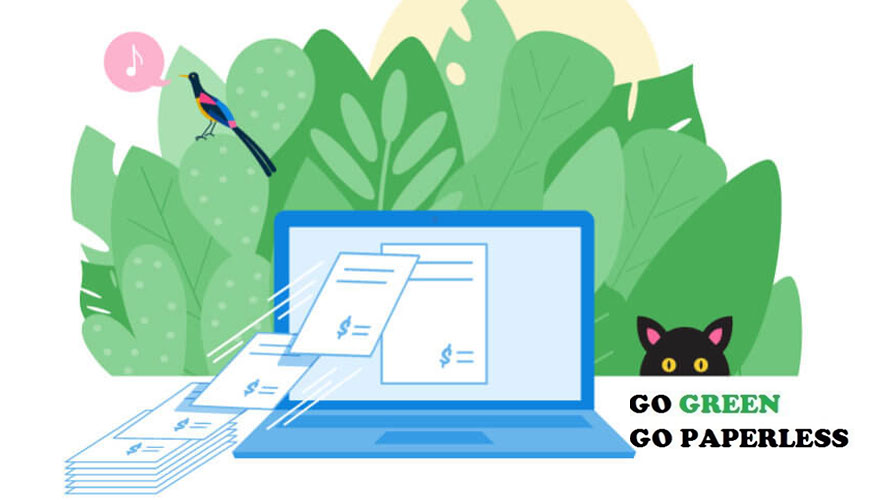
Plain and simple – paper is wasteful!
Although paper costs only about a penny per sheet, its use and production extract a much higher price from our environment.
From forests to offices, not only does paper contribute to problems such as deforestation, aquatic pollution, and air pollution, but also it squanders many precious natural resources, like clean water, oil, and energy.
Moreover, the wood pulping process in paper production requires chlorine and produces dioxins, one of the most poisonous byproduct pollutants humans generate.
That is paper – a disaster!
Here are some facts and stats to back this statement:
- 1 ream (500 sheets) uses 6% of a tree. (Source: Cushman-Roisin)
- Global paper usage has increased by 400% in the last 40 years. (Source: EPA)
- It takes 10 liters of water to produce a single A4 sheet of paper. (Source: The World Counts)
- 55% of the global paper supply comes from newly cut trees. (Source: The World Counts)
- The average cost of a wasted page is $0.06. (Source: WNYRIC)
- Producing 1 kilo of paper requires 2-3 times its weight in trees. (Source: The World Counts)
- Paper waste accounts for around 26% of solid landfill waste. (Source: The World Counts)
- It takes 1 tree to produce 12,500 sheets of paper (about 25 reams). (Source: Fujistu)
- The US uses approximately 68 million trees annually to produce paper and paper products. (Source: Green America)
- If everyone used 200 kilos of paper annually, no trees would be left. (Source: The World Counts)
Between these facts, the relieving thing is that most environmental experts agree companies can lower their carbon footprint by going paperless.
So in this article, we’ll discuss the steps and environmental benefits of going paperless but let’s first understand what carbon footprint actually is.
What is a Carbon Footprint?
A carbon footprint is an amount of carbon dioxide (CO2) or greenhouse gases (GHGs) emitted into the atmosphere due to personal or corporate activities.
It is often measured by the weight of carbon released into the air, ground, and water.
The main causes of carbon footprint are food, consumption, transportation, and household energy.
The lower the carbon footprint, the greener your business will be.
An individual’s carbon footprint is negligible compared to a company’s.
Some companies like transportation and manufacturing have an unavoidably massive carbon footprint.
Nevertheless, there is something every single organization can do right away to reduce their carbon footprint – go paperless.

How Does Going Paperless Lower Your Carbon Footprint?
Paper production and consumption are growing at an alarming rate, which has a significant negative impact on the environment.
The notable adverse side effects of the carbon footprint on the environment include:
- Climate change
- Forest loss
- Toxic acid rain
- Melting of glaciers and polar ice
- Coastal and ocean acidification
- Urban air, water, and land pollution
- Depletion of natural resources
Every year, we produce around 420 million tons of paper and cardboard.
However, it’s not just the amount of paper produced that hurts the environment; it’s also how it is made. The process of paper production includes:
- A sheer volume of trees
- Manufacturing
- Transportation emissions
- Water consumption
- Cost and pollution from recycling
All environmentalists agree that constantly increasing paper production and usage will soon become a global crisis if individuals and companies don’t take the necessary steps to reduce paper usage.
The environmental benefits of going paperless include:
-
Reduced Waste
While over 50% of a business’s waste is composed of paper, paper also makes up over 25% of solid landfill waste.
Additionally, paper production itself creates an enormous amount of waste.
So switching to a paperless office can help decrease these side effects of paper production.
-
Reduced Deforestation
Forests are essential to our lives, but unfortunately, we cut down millions of trees every year just to make sheets of paper.
As per World Wildlife, the pulp and paper industry accounts for 13-15% of total wood consumption globally.
Human-driven deforestation destroys ecosystems vital to wildlife and humans, increases the risk of major soil erosion, and contributes to climate change.
Going paperless gives you a huge opportunity to save forests and impact the environment positively.
-
Reduced Use of Water
Paper-making requires an immense quantity of water.
Even producing a single sheet of paper requires more than 3 gallons of water.
The projections suggest that many areas of the UK will face significant water deficits by 2050.
Saving water can help tackle climate change. By going paperless, you contribute to saving water on an already drying earth.
-
Reduced CO₂:
Producing paper requires a tremendous amount of energy.
It is estimated that turning a single tree into 17 reams of paper emits around 110 pounds of CO₂, polluting the atmosphere.
Plus, the transportation and distribution of paper often rely on fossil fuels that emit carbon.
Moreover, paper decomposition emits methane, which is an even more toxic greenhouse gas.
One study found that processing invoices digitally can reduce greenhouse gas emissions by 63% per transaction.
Moreover, a typical tree absorbs around a ton of CO2 over 100 years, meaning that going paperless can significantly reduce carbon emissions.
Steps for Going Paperless
If you’re wondering how to reduce your carbon footprint, these steps can help you:
-
Move to Document Management Software
One of the best ways to go paperless is moving to a document management software like Docsvault.
It allows you to capture, manage, share, and secure all your paper documents in a centralized location.
You can access your documents anytime, anywhere, using any browser or mobile with its Android or iOS app.
Using document management software will not only reduce your company’s carbon footprint significantly, but it will also help you save on paper costs.
-
Scan Paper Docs Into Digital Docs
Another efficient way to go paperless is document scanning.
Using a digital scanner, you can store all your documents electronically.
Digital documents are easier to manage, quicker to locate, and far more secure than paper ones.
You can even send all of them instantly to people who really need them.
And the best thing? You never have to worry about losing them.
For simplifying the document scanning process, it’s highly recommended that you opt for a document management system with built-in scanning software.
-
Use Web Forms Instead of Paper Forms
Electronic web forms are a great way to promote paperless sustainability.
They are easier to create, fill, store, and manage.
With eForms, you can gather critical data quickly and more effectively to speed up your business processes.
The seamless and paperless data collection process significantly reduces the cost of handling collected data and promotes a “greener environment” in your organization.
-
Sign Documents Digitally
One of the most common reasons to keep paper around is the need for signatures.
However, if you create your digital signature and save them to document management system cloud storage, you’ll never have to print a copy again.
In other words, signing documents digitally allows you to confirm your signature without paper.
Additionally, digital signatures protect you from document forgery and similar frauds, speed up the approval process, and help comply with regulations.
-
Share Documents Online
Finally, share the necessary documents online.
Not only does this positively impact the environment, but it also makes collaboration faster and easier.
Using public share links is the safest way to share documents with other people online.
They are more reliable and secure than traditional ways of sharing files online, like email attachments, FTP, and third-party share websites.
Benefits for Going Paperless
From environmental to economic level, the benefits of going paperless are substantial. Here are the top reasons why your company should adopt a paperless office:
- Reduced Carbon Footprint
- Better Document Organization
- Reduced Operational Costs
- Better Collaboration
- Streamlines Workflows
- Speed Up Approval Processes
- Data Backup & Disaster Recovery
- Compliance with Regulations
So, are you ready to go paperless?
Start your journey today with Docsvault and enjoy a variety of paperless benefits. Try an instant demo and see how much it can benefit you!